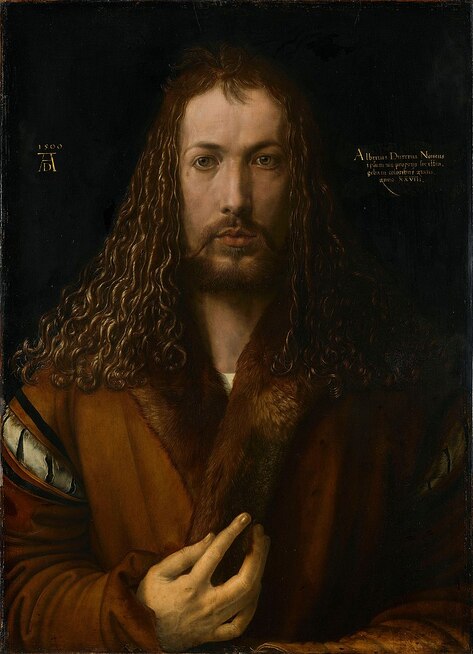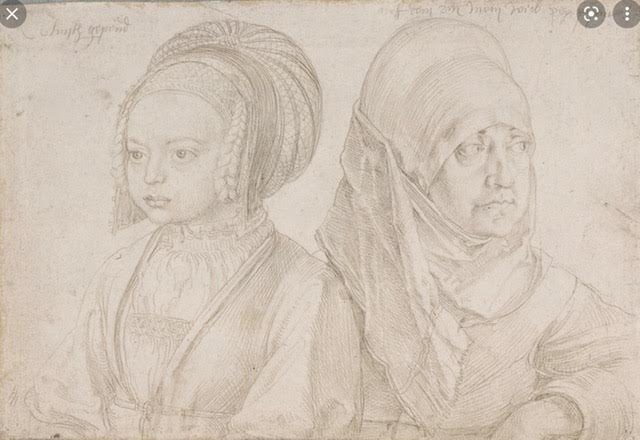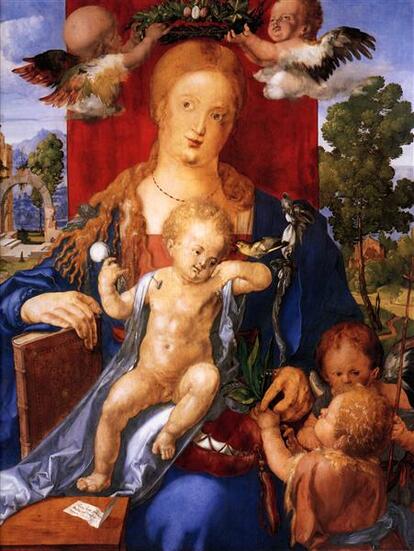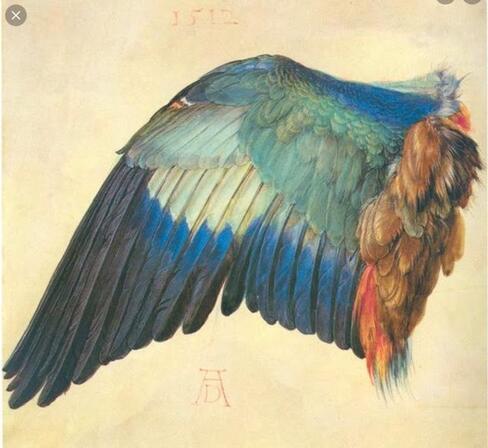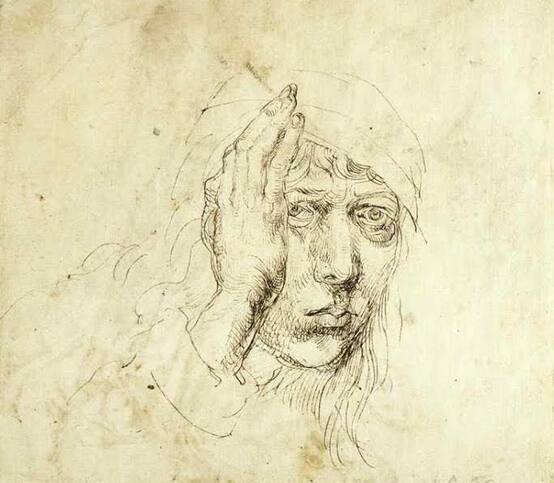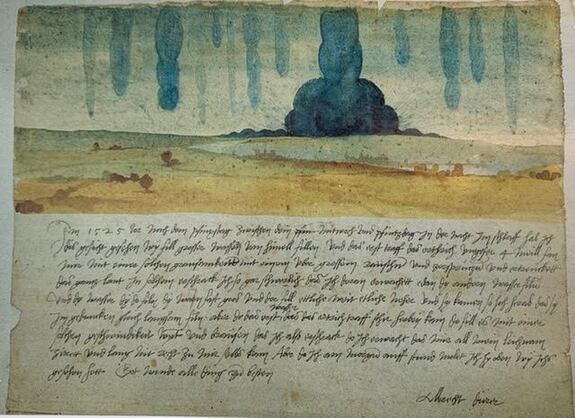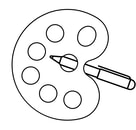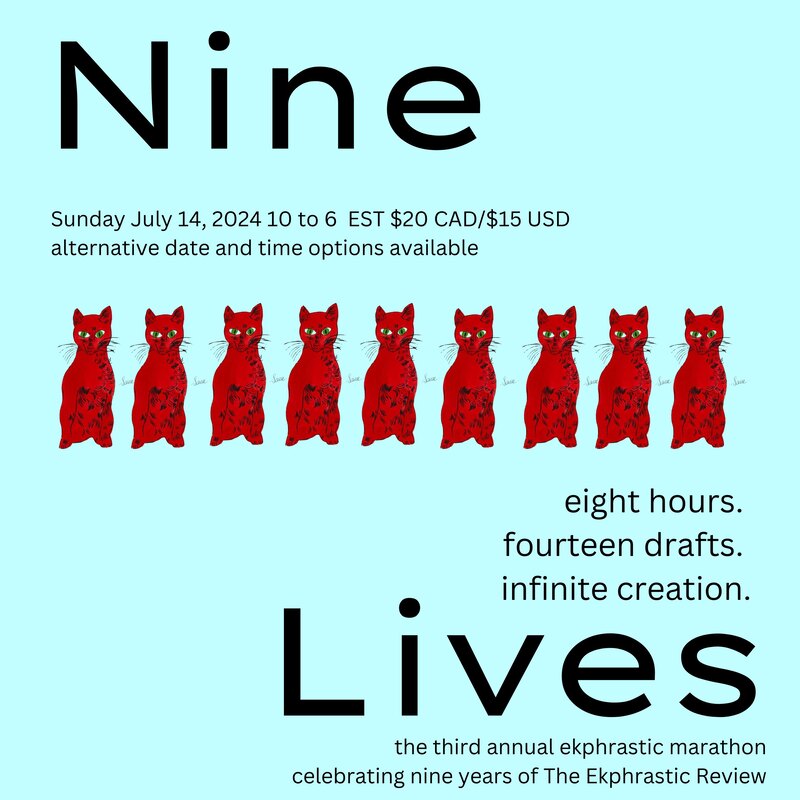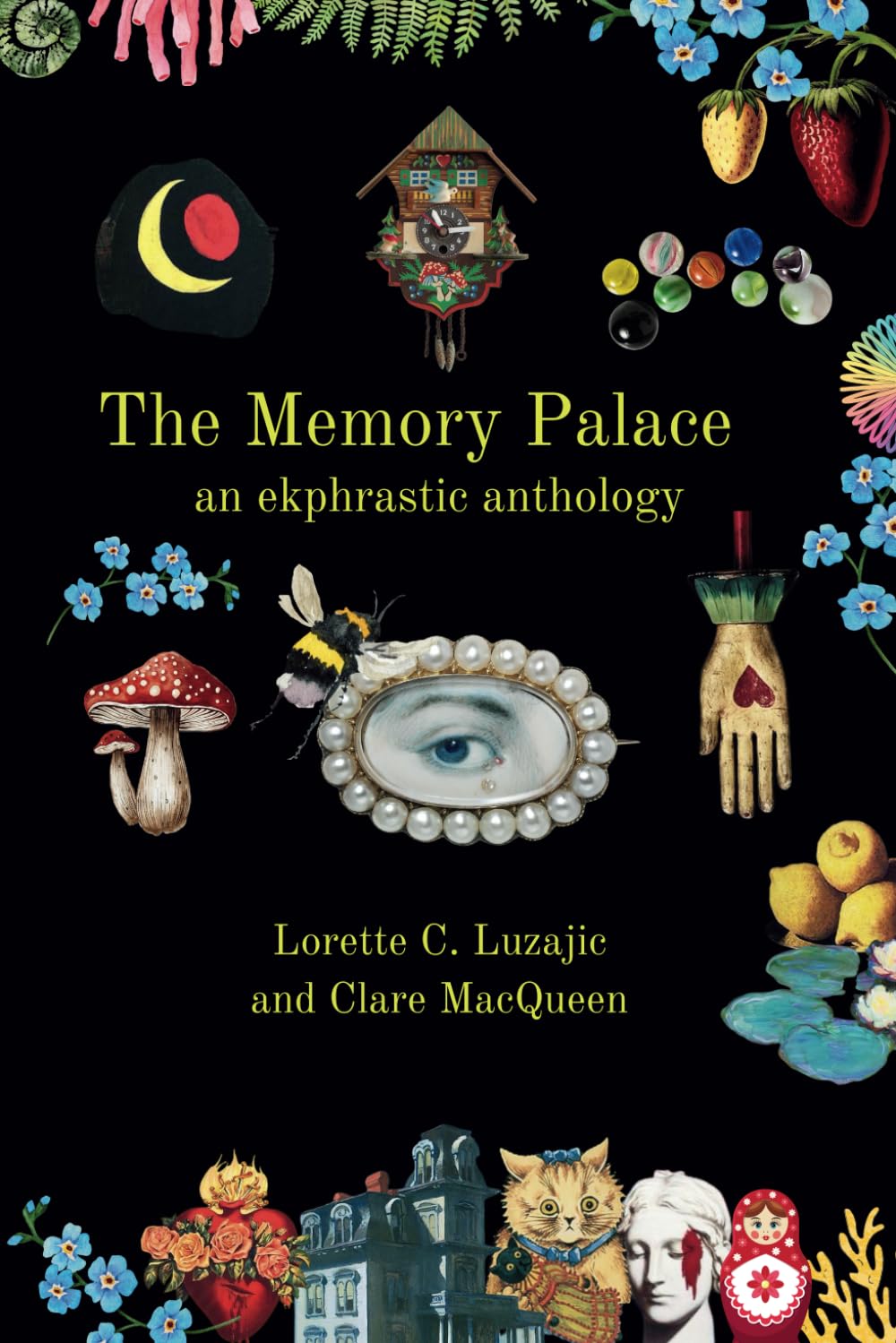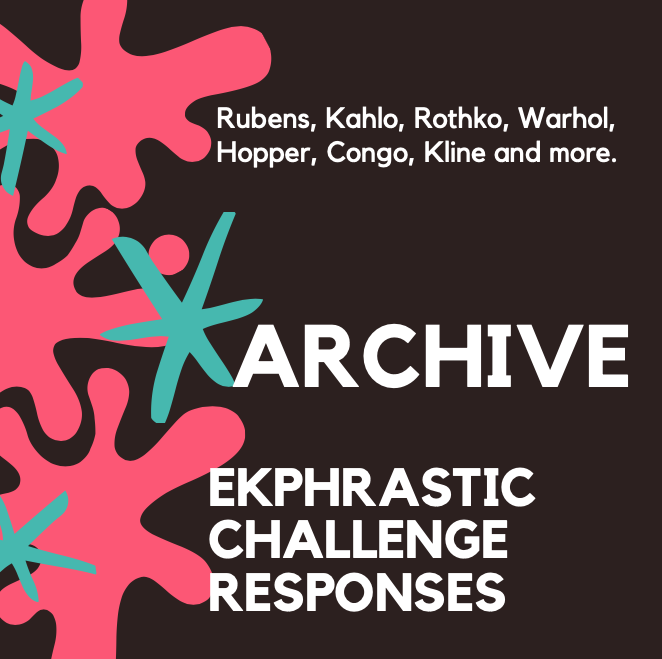|
In Search of Albrecht Dürer (1471-1528) Let me reach through the scrim of five centuries with the language and hindsight of today - to see what I can hold. Morning Outside the window water saturates the sky, the branches are smudged, soft rivulets course through a distorted heaven. This dreamy otherness with its mellow linearity asks for the brush, just a touch of colour and an abundance of water. The willow branches hang low over the stilled water, each one tipped by a quivering globule of liquid. Willing and pensive they sway over their own reflection. This suspension of light, this diffusion of water in air feels like a breath held – when I do breathe out and open the window, the moist, invigorating morning air brushes my face. Below me, in the workroom, I hear footfall, the clearing of phlegm from a night-time throat, and the soft shuffle of my apprentice going about his duties. I will be down shortly. ** What is Beauty? What is beauty I am asked time and again, my answer, “I do not know,” never satisfies. Pressed, I suggest – usefulness, pleasure, and harmony but never seem to give satisfaction. Beauty, my eye tells me, is there in the unformed figure of the young girl, her already too tight bodice encasing her like a bud, in her unfocussed gaze, her lack of knowing, much like in her counterpart, the old woman, the withered crone of my drawings, with her ropey neck, emptied out clavicles, caved-in cheeks and mouth drawn tight that speak of the life endured. I remember reaching for the charcoal stick to release my compassion into the fluting, draping lines, the faint criss-cross strokes across her chest, her heart. But her gaze, that vast pool of disillusionment, has let go of life’s concerns and found a new focus – blankly resigned to whatever time is left. How quickly her familiar face had taken shape under my hand, as I, with a son’s loving surety, smudged the charcoal’s soft burr to soften the lines that life engraved, and that I, it seems, was destined to retrace. Double Portraits As I smooth out the latest likeness of Agnes, my wife, on the worktable, I wonder what made me explore the “double-portrait” the way I have. There are several of them by now, all done over the past year – in the latest, a young girl from Cologne, dreams herself outward just beyond the imagined frame, while my Agnes, her back turned on the girl, fastens her eyes unswervingly somewhere beyond the margin. She will not approve of her likeness, I think – not, that she would tell me as much – she never lost that tightly wound look that I caught in my first drawings of her. And she would be right. There is pain here, the pain of the childless woman trapped in my portrait next to the great absence in her life. Am I cruel to touch that wound with my fine silverpoint pencil, which line-by-line makes this absence become flesh beside her? In other portraits: “Young woman-Old woman”, or “Tobler and Pfinzig,” the pairings were dictated by reason, urged on paper by my entranced hand which loves texture of dress and ornament, yet also tries to delve beneath the surface of skin and bone to snag character in a pair of pursed lips, or the burn and gleam of a pair of eyes. Only one double portrait stands apart: “Caspar Sturm – River Landscape”. Caspar, a huge solid man just took possession of the page. His rough-hewn jaw, dimpled chin, sensitive mouth a perfect study in contrasts – even his eyes with their characteristic cast of one eye looking fiercely ahead, while the other, obliquely turned right, speak of the man. I well remember his soft cap, its complex many-folded shape, earflaps slightly askew as if he had just walked in off the street. No, Caspar’s portrait would not suffer another’s by its side. Instead, I filled in a delicate river landscape, its shore lined with heavy fortifications like the ramparts of an old town. More of a dreamscape, than one seen by the daytime eye. I was never sure whether Caspar approved of this likeness, whether he even recognized himself. Perhaps he just thought I had done well by showing the intricate folds of his homely cap and the narrow ribbon that tied his shirt shut at the neck. By way of an afterthought – two years later, this very same Caspar, aided our man Luther’s escape to the Diet of Worms. ** Noon – or Thereabouts There is always a part of me that harkens to the noises of the household, the part, furthest removed from my point of concentration. At times, my hand does one thing, while I, in another realm, pursue something yet unthought. I may hunt down this elusive prey for days, even weeks. It even invades my sleep – often to good effect. This silent pursuit along a fine-honed edge of attention can lead me to a place, where what my eyes have held, and what my hands have learned, coalesce to bring forth something new. This liminal space I consider my real workshop. Untouched by weather, the tempers of the household, considerations of economy, practicality, and above all, the desire of others, it is my one free space. Carduelis Spinus - Siskin My apprentices often scatter the leavings of their meals along the windowsill. Just now, a slight, scrabbling sound from the open window makes me lift my head from the quarto sheet, and I see, as expected, the compact olive green body, the cadmium-yellow streaked wings, the sooty bib and the tell-tale, inked cap of a siskin. They are numerous around here, filling the air with their ascending and descending trills, their effortless, rapid twitter. Their flitting about, their sudden disappearances remind me of the old tale of the Siskin’s magic stone: the one they guard closely in their nests to assure invisibility. Some time ago I painted one such bird – made him permanently visible. In Madonna with the Siskin, a humble siskin alights on the infant’s left arm, wings aflutter, it animates the whole scene. Wings: Blue Roller and Angels I cannot recall the exact moment when fate dropped the wing of the Blue Roller on my worktable. Not the whole bird, just its neatly severed wing. There it lay, spread out like a fan from the orient, in breathtaking colours of indigo, iron ore, verdigris and wet clay. It recalled the charming tale, apocryphal or not, of the male, who as part of his courtship dance, presents, holding a feather in his beak. This wing unfurled, its complex layers, gradients of colour culminating in veritable cumulus clouds of grey-tinged green, is held by the deep indigo band of the shoulder. How well I remember the pleasure of losing myself in the minute strokes of the downy afterfeathers, which, light as air, put one in mind of the very idea of flight. How often have I crowded my scenes of veneration with countless putti and angels? The whirr of their wings have filled whole images. I wonder, are these the wings of my belief, or of my doubt? “Behold the Man” This is the beginning: age thirteen. My very first self-portrait, its tender half-profile catches the still slumbering awareness of my younger years, each subsequent portrait, in tandem with my standing in the world, moves in increments from delicate silverpoint to the “undying” colour of oil. What was I searching for beyond the act of showing? Beyond the sumptuous silk, the lavish fur trim, the brocade and tassels, my indulgent depictions of hair and my fair countenance, beyond documenting my increased value to the world? Yet, I remember other portraits amongst the many – where, by unmasking skin, bone and sinew my body speaks truer. One, in particular, where my probing look reaches out from the canvas and shows a troubling awareness in the hand raised to shield my face. Was I trying to lift the veil that slides between us and our true knowing of who we are? That sphere just below, and beyond our ken, where we, and what we might be, lies dreaming? Yes, I was searching. Am doing so still. Am still, above all, my own “Man of Sorrows.” The Dream This dream, this vision of the night, ineffable and powerful, took hold of me between Wednesday and Whitsuntide: … great waters fell from the sky four miles on, they hit the earth with such cruel, momentous splashing, such a fury of sound, that all of the land appeared drowned. Some of it fell further away, some closer, giving the appearances of slow motion – but wherever the water hit, it did so accompanied by strong winds and a sound so wrenching, it tore me out of the dream and left me trembling – and for a long time, I could not find back to myself… May God turn everything for the best.* When I surface sucking the air like a man returned from near drowning, I reach for my pen and watercolours. A delicate wash of cobalt seeps in loose runnels from a wan sky, the center column, in a deeper hue, piles volume on volume. Masses of water spreading above patches of delicate ochre that dot a bereft landscape. Why this dread? Why this feeling of apocalyptic doom? What unnameable thing fills me with such terror? Could it be the undoing of form as colour drips like hot wax from an amorphous sky? Or is it the very loss of line, of verisimilitude that throws my art into question? *translation my own ** Night Thoughts How rare these moments of true silence during a sleepless night a silence in which the world itself seems to have fallen by-the-way and yet, I discern a cooling breeze playing in the far-off trees, then, a short scuffle in the courtyard below as if the dogs were torn out of their dreams much later, further off, but coming closer, a rumbling of wheels on cobblestones, their grating metallic ring reverberating on stone I must have fallen asleep just now – found myself back in Antwerp – on the ship. Once more, we were about to be swept out to sea, helpless puppets at the mercy of the fickle elements my life, my life’s work, the grandeur, the hardship, the pain, the joy and the glory no more than the ephemeral gestures of wave after wave dissolving. Finally, the sound of early morning bells, their intermingling harmonies, and the discordance of one belfry competing against the others like a rival belief call me back to the work still undone, and the remaining years waiting to be rounded off. Barbara Ponomareff Barbara Ponomareff lives in southern Ontario, Canada. By profession a child psychotherapist, she has been fortunate to be able to pursue her lifelong interest in literature, art and psychology since her retirement. The first of her two novellas, dealt with a possible life of the painter J.S. Chardin. Her short stories, memoirs and poetry have appeared in Descant, (EX)cite, Precipice and various other literary magazines and anthologies. She has contributed to The Ekphrastic Review on numerous occasions and was delighted to win one of the recent flash story contests.
0 Comments
Your comment will be posted after it is approved.
Leave a Reply. |
The Ekphrastic Review
COOKIES/PRIVACY
This site uses cookies to deliver your best navigation experience this time and next. Continuing here means you consent to cookies. Thank you. Join us on Facebook:
July 2024
|
